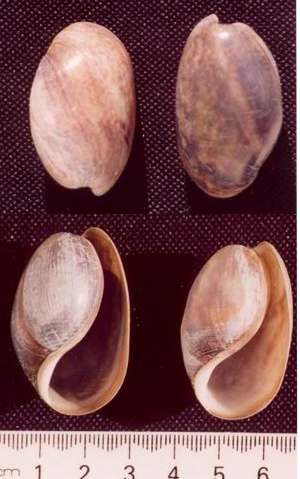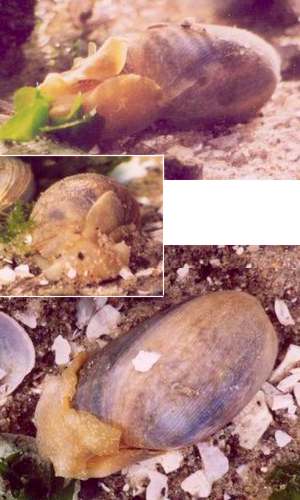Bulla quoyii from New Zealand
September 1, 2003
From: Paul Furneaux

PHOTOS: Bulla quoyii, Beach Rd-Harbour Drive, Tauranga Harbour, New Zealand, July 2003. Photos: Paul Furneaux. Upper right: dead animal plus whelks.
Lower left: Shells. Lower Right: views showing live animal, lateral view (upper), anterior view (middle), animal half extended (lower).
Dear Bill,
Here are some photos of Bulla quoyii that have been quite a challenge to obtain. These animals are apparently quite common in Tauranga Harbour, New Zealand, if their empty shells are anything to go by, but finding and working with living animals is something else again and I have had to resort to using an aquarium to obtain these few shots. They are such shy, reclusive "critters". The headshield and foot is a beautiful honey-gold colour with flecks of a lighter pale colour scattered over it. The leading edge of the headshield is interesting in that at each "corner" there appears to be a fold which is perhaps the forerunner of a more specialised sensitive area/tentacle?
All of the empty shells and live animals (only 5) that I have found have been from the lower intertidal part of the flats, within the region that I have previously described for Aplysia juliana, Pleurobranchaea maculata, Melanochlamys cylindrica, Philinopsis taronga and Haminoea zelandiae. There appears to have been a fairly high death rate among the Bulla population during July - August because the number of "fresh" shells observed has been significant during these months and also the number of "newly dead" animals encountered has also been significant. These "newly dead" animals have a very distinctive pose, upside-down, headshield and foot obvious, and usually with the first few scavengers gathering, mostly Cominella species but the occasional Melanochlamys and Pleurobranchaea have also shown an interest.
I have not come across the egg mass of Bulla thus far but perhaps the season is not yet right. According to Willan and Morton (1984) the eggs are red and should be easy enough to identify once the egg mass is located. (By comparison the egg masses of Haminoea are incredibly numerous at present) The winter months seem to be busy times in terms of sea slug reproduction here in Tauranga, something that I did not expect but perhaps related to predator avoidance or in some way enhancing survival chances for larvae?
• Willan, R. & Morton, J. (1984) Marine Molluscs. Part 2. Opisthobranchia. Leigh Marine Laboratory, University of Auckland, New Zealand.
Regards,
Paul Furneaux.
P.Furneaux@xtra.co.nz


Thanks Paul,
As you have found, there can be huge banks of dead shells, but little sign of live animals. Concerning the apparent increase in reproduction during winter months, we certainly need more long-term studies like yours to see what is going on. One important point to take into account is the availability of food. In New Zealand and parts of Australia, summer months are when the lowest tides occur during daylight hours, and so coincide with the hottest times of the year. This is not a good time for intertidal animals, especially on intertidal sand and mudflats, when even the water in shallow pools is likely to 'cook' the animals. It is also not a good time for many algae, especially the filamentous greesn and Ulva which herbivorous cephalaspideans feed on.
Best wishes,
Bill Rudman
Related messages
-
Re: Bulla quoyii from New Zealand
From: Graham Bould, December 18, 2008 -
Bulla quoyii - mass mortality
From: Paul Furneaux, December 9, 2003 -
RE: Bulla quoyii - breeding observations
From: Rachel Przeslawski, November 19, 2003 -
Bulla quoyii - breeding observations
From: Paul Furneaux, November 18, 2003 -
Handy Hints for finding Bulla quoyii
From: Paul Furneaux, November 14, 2003 -
Bulla quoyii from South Australia
From: John Chuk, September 3, 2003 -
Re: Bulla quoyii from New Zealand
From: Audrey Falconer, September 2, 2003
